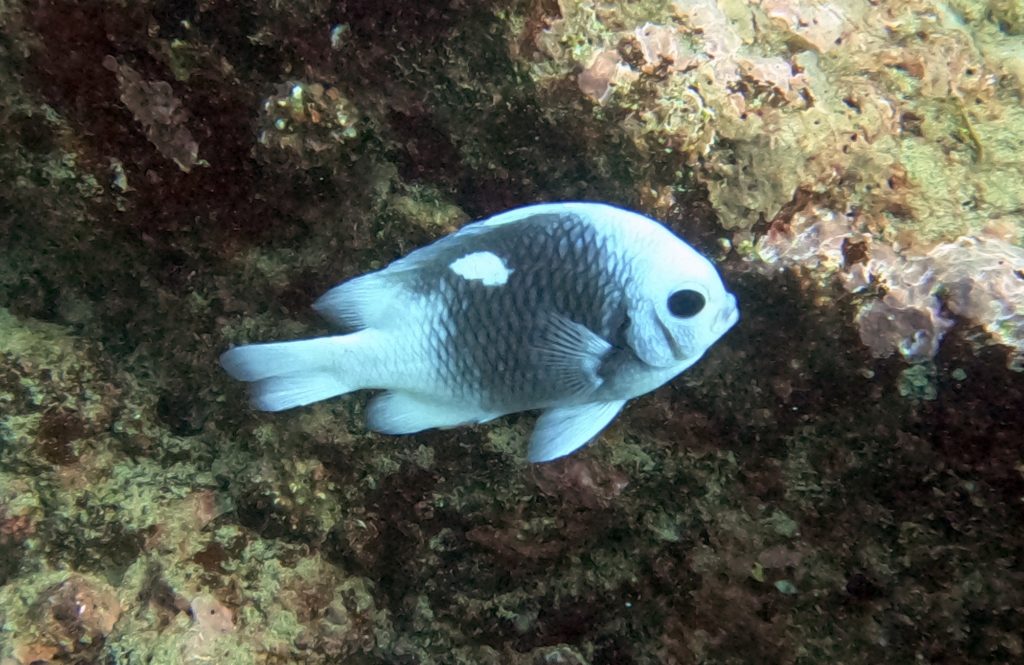We took our first French Polynesian scuba dive off the back of our boat, and swam up towards the point between the two anchorages. We didn’t change the battery in the camera, and Jazz’s regulator was leaking air, so it was a shorter dive with no pictures. We barely made it to the pinnacles before it was time to turn around and swim hurredly back. But we got back in the water two days later, with Acushnet and Sava along, and got some pictures. New dive partners always take some time working out how to communicate, which resulted in an amazing group photo.



These were our first dives in the Pacific, so it feels like everything is new, and we’re unreasonably excited about what will most likely, in a couple of months, feel like super common fish. First up, several big schools of bluestreak fusiliers.


There are way more varieties here from the familiar categories, like this bluespotted bristletooth (a kind of surgeonfish). Or the damsel on the right, which doesn’t look like anything in our book but twinspot is the closest, so maybe that?


We absolutely loved the Moorish Idols, with the long trailing fin and intricate facepaint. The wrasse, top right, had very striking markings, which don’t quite seem to match anything in our guide; we saw several that looked just like this so we doubt it’s a juvenile phase or something. We also saw several of these redtoothed triggerfish, which run away from the camera when “threatened”.



There were some free-standing coral formations away from the pinnacle, one of which harbored this (yellowmargin?) moray.


The sea cucumbers are new too: here’s a pineapple, and one we can’t figure out but also saw a lot of.


We saw new kinds of urchins, like the cake urchin on the left, and the flower urchin on the right: these guys like to cover themselves with rocks and debris which we found adorable.


Left, a guineafowl puffer, and (we think) a female Whitley’s boxfish with its big horizontal stripe, apparently rare except here in the Marquesas. On the right, a male spotted boxfish showing off its bright yellow spots.



Along the rocks by the surface, a school of flagtails. And then someone looked out into the blue in the opposite direction, and spotted a trio of spotted eagle rays! Blurrycam but it still happened.


On the left, a cushion star, the blobbiest starfish we’ve ever seen. We couldn’t ID this hairy yellow hermit crab, but it was cute.


So that was our first two Pacific dives! That would normally be all our capacity, since we only carry two tanks each. But Acushnet filled our tanks for us with their compressor, because they are amazing humans. Our next foray into the water was in Ivaiva Iti, where the clear sand bottom hosts very few fish but a lot of manta rays! We saw them off the boat as we anchored, then snorkeled with them a couple of hours later.
We got in again that night, off the back of Acushnet, whose blue underwater lights seem to magnetically attract the mantas. They swarmed around us as we knelt on the ocean floor, playing chicken as they swam right at us and occasionally brushing us with their fins.
It was incredible. For the first time, it felt like we had really arrived in the Pacific, doing something that would not be possible anywhere else.










We went snorkeling two more times, around the edges of the bay, and ran into some other new-to-us fishies. Like this striped surgeonfish, and the school of orangespine unicornfish (which ran away from the Jazzfish and the camera).



We found a new variety of lionfish, a spotfin we think. And many new varieties of triggerfish, like the scythe and wedgetail pictured here, and the pinktail triggerfish that got away.



These ornate butterflyfish are very pretty. The manybar goatfish, top right, is not, but it’s striking how different it looks from its Caribbean cousin. Also pictured, the yellow variation of a guineafowl puffer.



Andrew loved the blue iridescence of this urchin. We still can’t precisely identify the damselfish with the spot, like the one from the first set of dive photos, or this spotty little grouper.



This gray large-eye bream was super calm about us approaching. The orangeband surgeonfish was a little more wary, but there were lots of them. And even more of these stripey fellows, bluestripe snapper?



Also reluctant to sit for a photo were several whitespotted surgeonfish. And finally, on our way back to the boat, we saw this three-foot-long star puffer just chilling above the sand, maybe twenty feet down.



Great photo’s. Have seen a lot of the same fish and other. Question? What is the temp of the water there. You guys looked like you were suited up hood and all. Tried to go diving in Mallorca but it fell through at the last moment. Water temp was 71 and i would have wore a 7 mil. Not a fan of cold water. Loved your stories dad
The water is usually in the low to mid 80s, but it’s colder at night. Worth it for the mantas though!
Those Mantas are awesome!
Right!? One of the best experiences of our lives.